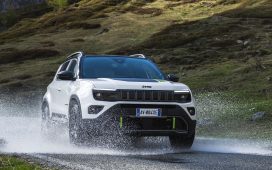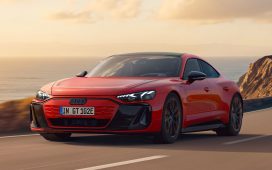The Macan is a hugely important car for Porsche. First introduced in 2013 as a more compact cousin to the Cayenne SUV, it quickly became the best selling model in the Porsche lineup. What is even more important to the company is that 80 percent of Macan buyers are new to the Porsche brand. Making a battery electric version of the car is a huge risk for the company. Porsche certainly doesn’t want to mess with the success of its most popular car and will continue to sell the combustion engine versions of the Macan until such time as the market decides whether the EV is superior to the conventional product.
The battery electric Macan will come in two trim levels to start, both with dual motors and a 95 kW (net) battery composed of 12 modules, each with 15 prismatic cells. The car is built on the Premium Platform Electric (PPE) platform jointly developed by Porsche and Audi and features 800 volt architecture. The electric Macan can accept up to 270 kW of charging power, enough to get from 10 percent to 80 percent in less than 22 minutes using a 350 kW charger. Adding 60 miles of range takes just 4 minutes when starting at that 10 percent state of charge. The battery pack can also function like two 400 volt units wired together in order to promote faster charging from less powerful chargers. AC charging at up to 11 kW is also part of the charging package.
Macan 4 And Turbo By The Numbers
The Macan 4 lists for $78,800, just a few dollars more than the conventional Macan T, which has a turbocharged 2.0 liter four cylinder engine and starts at $76,355. The electric Macan 4 has a combined 402 horsepower (300 kW) and 479 ft lbs (650 Nm) of torque. It does the 0 to 60 mph sprint in 4.9 seconds and has a top speed of 136 mph. The conventional Macan T has similar performance specs.
The Macan Turbo, which starts at $105,300, has no turbo, oddly enough. Instead its two motors combine for 630 horsepower (470 kW) and 833 ft lbs (1130 Nm) of torque that slingshot it to 60 mph in 3.1 seconds and to a top speed of 161 mph. The Turbo accelerates to 60 mph one second quicker than the $99,500 conventional Macan GTS with a turbocharged V-6 engine. Many folks would be quite happy to fork over another $5000 to slice a second off their car’s 0-60 time.
Both Macan EVs are all-wheel drive, with motors at the front and rear axles according to a Porsche press release. In normal operation, 100 percent of the drive is provided by the rear motor — the more powerful of the two. However, the control system for the power train can instantly bring the front motor into action when the driver tromps on the exhilerator. The onboard computer can vary the torque split between the two motors depending on which driving mode the driver has selected — Normal, Sport, Sport+, or Off Road. The front motor also supplies regenerative braking at up to 240 kW of energy. The rear motor uses a silicon carbide inverter to boost performance, according to the Robb Report.
Both electric Macan models come standard with height adjustable air suspension and Porsche Active Suspension Management. PASM uses new two valve shocks that allow compression and rebound damping rates to be individually controlled to ensure a wider separation of damping characteristics in the different drive programs. Standard ride height is 7.1 inches, but selecting Sport+ drops it to 5.9 inches, while Off-Road mode raises it to 8.7 inches.
Rear wheel steering is available as an option. The system will turn the rear wheels by as much as five degrees in the opposite direction to the front wheels at low speeds to deliver a turning circle of 36.4 feet in urban traffic. Above 50 mph, the system switches to same phase steering for better high speed stability. Macan EVs with rear-wheel steering are also equipped with a front-steering rack that is 15 percent quicker than the standard item.
The Macan Turbo gets an electronically controlled rear differential to improve traction and handling. The Porsche Traction Management system operates about five times faster than a conventional all wheel drive system and can respond to wheel spin within 10 milliseconds.
Sporty Looks And Smart Aero
“With the all-electric Macan, we are presenting the first Porsche that we are taking electric from an established product identity,” says Michael Mauer, Vice President Style Porsche. “The new Macan is clearly recognizable by its brand identity as part of the Porsche product family. The classic Porsche proportions have been further developed and optimally adapted to the challenges of an electric vehicle. This has further heightened its sporty, modern and dynamic appearance. The design makes it clear — the Macan remains the sports car in its segment, even in electric form.”
Dimensionally, the electric Macan is 2.3 inches longer and 1 inch taller than the conventional Macan. It also has a 3.4 inch longer wheelbase, which results in more rear seat room and carrying capacity for the stuff people bring with them when they travel. There is even a frunk with 2.9 cubic feet of extra storage room.
Because efficiency is critical to battery powered cars, Porsche engineers have created carefully developed active and passive aerodynamic systems, including an adaptive rear spoiler, active cooling flaps on the front air intakes, and flexible covers on the fully sealed underbody. In addition, air curtains below the headlight module and front bumper optimize the air flow. All of these considerations have resulted in a drag coefficient of 0.25, which is pretty impressive for an SUV. The Tesla Model Y has a Cd or 0.23. Porsche has not released any WLTP or EPA range numbers as of yet.
The infotainment system in the battery Macan is based on the Android Automotive operating system, which allows the use of third party apps and more powerful voice activation functionality.
The Takeaway
All in all, the electric Porsche Macan is a tasty little crumpet that should find a ready audience among prospective customers. It is priced just a few dollars more than the conventional Macan, which undercuts the urban myth that electric cars cost way more than conventional cars.
Porsche has has great success with its first battery electric car, the Taycan. Everything the company learned from designing and building that car has been poured into making the electric Macan as compelling an EV as possible.
Have a tip for CleanTechnica? Want to advertise? Want to suggest a guest for our CleanTech Talk podcast? Contact us here.
Latest CleanTechnica TV Video
I don’t like paywalls. You don’t like paywalls. Who likes paywalls? Here at CleanTechnica, we implemented a limited paywall for a while, but it always felt wrong — and it was always tough to decide what we should put behind there. In theory, your most exclusive and best content goes behind a paywall. But then fewer people read it!! So, we’ve decided to completely nix paywalls here at CleanTechnica. But…
CleanTechnica uses affiliate links. See our policy here.











